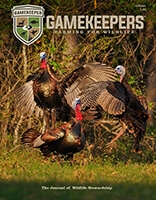Considerations Before Planting
Whenever it comes to food plots, some of the first few considerations to think about are how much space is available and is there access to that location. Then you have to think about the quality of the soil, aspect to the sun, and other details. Not every landowner has access to large tracts of flat, tillable ground, but instead, many properties have secluded hideaways that can provide the perfect location for small food plots for deer. Since they are off the beaten track, it just might take a little extra effort to get the job done, but your smaller plots can have tremendous benefits for your wildlife.
The Benefits of Small Food Plots for Deer

Jarrod Stephens
Having hidey hole plots dotting your spread will create more feeding options for wildlife and also present you more places to set up a hunt. You can beat varying wind directions by having your setups in different areas around the smaller secluded plots. As hunting pressure mounts, your deer will be less likely to venture into larger, more open areas, but may continue to use the small plots closer to their bedding areas. Whenever your small plots are adjacent to cover, other game will also benefit as they will be able to escape predators easier. Creating a hideaway plot is not as simple as clearing the land, casting seed, and reaping the benefits. Without proper light, tilling, weed control and seed choice, your efforts will be in vain. It can be a lot of hard work but quite rewarding as well. Your hidey-hole plots can pay big dividends.
Create Your Own Hideaway
Creating a hideaway plot area is possible if you have the resources and the time. Of course, access, and choosing land that is not too rugged to till are imperative. If the use of heavy equipment such as excavators and dozers is not an option, you can resort to rolling up your sleeves and using a chainsaw. Assess your property and find usable land and even woodlands that can be cleared.
Carefully cut all trees flush with the ground. Clearing only the understory is typically not suitable for most plot plants, so removing larger trees to release sunlight through the canopy onto your future plot is important. Remember to only cut to the level of your expertise. Felling large trees can be difficult and dangerous for a novice.

Jarrod Stephens
Your initial efforts are not the final results, but can be a springboard for continual clearing for years to come. The more you open up a secluded area for plots the more options you will have when it comes to seed choice. Applying glyphosate or other herbicides to the fresh cut stumps should prevent the emergence of sprouts. It can also be applied to all remaining vegetation in the would-be plot area to prevent an overgrowth of unwanted plants. Native weeds are hardy and will grow vigorously, so weed control before you plant may be necessary. Always follow recommendations for proper application.
If you have recently had or plan to have a patch cutting timber operation on your property there’s a good chance you have some areas that are prime for hideaway plots. Patch cutting completely removes timber from a predetermined small area and will create diverse cover for wildlife. Choosing areas that are relatively flat for patch cutting can be a first big step, if you plan to use it for a secluded plot.
Following the timber harvest, you should remove all debris from your would-be plot. Complete stump removal is a good consideration if you have the resources, but if you are using an ATV and small equipment adapted for the vehicle then navigating the stumps should not be a problem. If stumps do remain, they should be cut level with the ground surface to avoid too much aggravation. Again, an application of glyphosate to the stumps should prevent the emergence of sprouts of many trees.
If your property was once a homestead and has been neglected, there is a really good chance that there are some areas on the spread that were once used for crops or pasture. If you do discover such areas that are overgrown, then you have found the perfect location for a plot. Only clearing the necessary debris will allow your new plot to remain secluded and it can become a wildlife magnet when the new tender plants emerge. Remove overhanging branches and larger trees that cast shade on the area. Most food plot crops will require at least six to eight hours of direct sunlight per day. Narrow slivers of land may seem insignificant, but an area of tender green can become a funnel for wildlife as they navigate your landscape. If it is a long, narrow spot, you must also consider its aspect to the sun to make sure the plants will receive enough.

Microgen
Soil Prep
Tilling former woodland areas can be tricky and time consuming. As you use a disk or harrow on the area, roots and rocks may continually emerge and need to be removed. In fact, this will likely be the case for several years as you fully establish your plot. Having a box blade or rake for your ATV or tractor can help you level the soil and remove debris. The rough soil and poor soil conditions will likely influence your seed choices for the first few years as you work to improve the overall soil health. If you are unable to till the soil, you should consider BioLogic’s Quick Sow Deer Plot mix. The 10lb bag sows ½ acre and no heavy equipment is needed for tilling.
Land that was once used for agricultural purposes is typically not as difficult to reclaim and prepare as a hideaway plot. The soil is likely in better condition than the soil of the woodland area simply because of its prior use. Again, the removal of stones and root debris is important as you prepare your soil for seeding.
Whether your hideaway plot was once a woodland area or agricultural field, chances are that competition with native plants will be fierce. For that reason, you should be prepared to use glyphosate or other appropriate herbicides to remove and/or control vegetation before you seed the area.
Adding organic and even chemical fertilizers along with lime can help your soil become healthier and more productive. To ensure that your soil has a proper pH you should conduct a soil test. Following the recommendations of the test will improve plant growth and foster a more productive plot. When possible, to begin with you should till the soil deep to create enough loose soil to cover the seed and allow proper aeration in the soil.
Seed Selection for Small Food Plots for Deer

Jarrod Stephens
You may find yourself working throughout the spring and summer to prepare your hideaway plot for fall seeding, so continual weed control is important. Plan ahead, whenever the planting window does open you want to have your seed on hand to get the growing underway.
If you are seeking quick results and plan to reseed the area again next season, you should choose an annual seed for the plot. Annuals are fast-growing and they can provide a lot of forage in a short amount of time. Spring peas, wheat and soybean are excellent choices for spring annual plots. Each must be given enough time to grow and mature before the end of your growing season, so it is good to have a clear understanding of prime planting dates for your region before putting the seed in the ground. Due to their fast-growing nature, annual plots consume a lot of nutrients from the soil which highlights the importance of regular soil tests and the addition of fertilizer to the soil.
It depends upon the type of equipment you’re able to get to the plot as to which seeds you’ll be able to consider. Sometimes these small, out of the way plots are done with a rake and a hand-seeder. In this case, planting depth of your proposed crop will need to be considered. You may need to use small seeds that only need to make contact with the soil in such an instance.
Brassicas and winter wheat are two tried and true seeding options that are well-suited for late summer/fall planting. Each will grow quickly and be winter hardy to provide sustenance during harsh winter months. The winter wheat will reemerge in the spring with tender blades and eventually heads of wheat just in time for spring turkey season. To get more out of your efforts adding a variety of clover seed is a good choice. Both annual and perennial clover can be used. At the end of the life cycle for annuals, the perennial clover will continue to thrive and provide a longer lasting food option for wildlife.
Perennial plots are the key to longer lasting results. Clover and alfalfa plots are the most common perennial plants for food plots with some clover plots lasting for up to five years, sometimes longer. For your more difficult to access hidey hole plots, clover is a wonderful choice. Not only can the plants endure for several seasons, but clover is also referred to as a “nitrogen-fixing” plant because it creates its own nitrogen and helps to improve the overall soil health instead of depleting the nutrients. However, these legumes require a pH close to neutral (6.2 to 7.0). Often plots found within timbered areas will have acidic soil. Without the ability to incorporate lime into the soil, other plants tolerant to a more acidic soil may be a necessary choice.
If you have areas where the timber has been harvested but access for tilling is nearly impossible, you may have a prime location for the addition of apple trees (or other mast producing trees) to your land. As long as the area receives full sun and you are able to control competing vegetation, a stand of apple trees can become a deer magnet once they reach bearing age.
Conclusion
Sure, the task of creating and maintaining a small plot that has tough access can be tricky. However, whenever you are diversifying feeding options and keeping your trophies out of view from other hunters, your endeavors become a win-win for you and others with whom you share your hunting property. Creating these hidey-hole plots can be the key to diversifying your nutrition program, maximizing the benefits for your wildlife, and creating awesome hunting locations.









